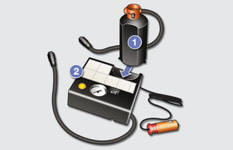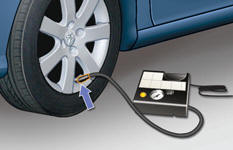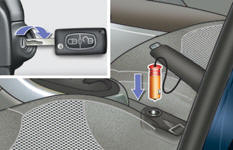Temporary puncture repair kit (308 SW with bench rear seat)

Complete system consisting of a compressor and a bottle of sealant which permits temporary repair of the tyre so that you can drive to the nearest garage.

The kit is stowed in the boot storage tray.
 It is designed to repair holes
of a maximum diameter of 6 mm, only where located on the tyre tread or shoulder.
Avoid removing any foreign bodies which have penetrated the tyre.
It is designed to repair holes
of a maximum diameter of 6 mm, only where located on the tyre tread or shoulder.
Avoid removing any foreign bodies which have penetrated the tyre.
Using the kit
Switch off the ignition.
Tick the wheel to be repaired on the speed limitation sticker enclosed then affix
the sticker to the vehicle's steering wheel to remind you that a wheel is in temporary
use.
Clip the bottle 1 on the compressor 2 .

Check that the switch A is tilted to position "0" .
Connect the pipe of the bottle 1 to the valve of the tyre to be repaired.
Unwind the pipe of the compressor 2 fully, then connect it to the bottle.

Connect the compressor's electric plug to the vehicle's 12 V socket.
Start the vehicle and leave the engine running.

Switch on the compressor by tilting the switch A to position "1" until the tyre pressure reaches 2.0 bars.

Remove the compressor and store the bottle in the plastic bag, supplied in the
kit, to avoid staining your vehicle with traces of fluid.
Drive immediately for approximately two miles (three kilometres), at reduced
speed (between 10 and 35 mph [20 and 60 km/h]), to plug the puncture.
Stop to check the repair and the pressure.

Connect the compressor pipe directly to the valve of the repaired wheel.

 If this pressure has not been
reached after approximately five to ten minutes, the tyre cannot be repaired; contact
a PEUGEOT dealer or a qualified workshop to have your vehicle repaired.
If this pressure has not been
reached after approximately five to ten minutes, the tyre cannot be repaired; contact
a PEUGEOT dealer or a qualified workshop to have your vehicle repaired.
Connect the compressor's electric plug to the vehicle's 12 V socket again.
Start the vehicle again and leave the engine running.

Adjust the pressure using the compressor (to inflate: switch A in position "1" ; to defl ate: switch A in position "0" and press button B ), in accordance with the vehicle's tyre pressure label (located on the door aperture on the driver's side), then remember to check that the leak is plugged correctly (no further loss of pressure after several miles [kilometres]).
Remove the compressor, then store the whole kit.
![Drive at reduced speed (50 mph [80 km/h] max) for no more than approximately](images/books/1072/8/index.68.jpg)
Drive at reduced speed (50 mph [80 km/h] max) for no more than approximately 125 miles (200 km).
 Visit a PEUGEOT dealer or a qualified
workshop as soon as possible to have the tyre repaired or replaced by a technician.
Visit a PEUGEOT dealer or a qualified
workshop as soon as possible to have the tyre repaired or replaced by a technician.
Take care, the bottle of fluid contains ethylene-glycol. This product is harmful
if swallowed and causes irritation to the eyes. Keep it out of reach of children.
The expiry date of the fluid is indicated on the base of the bottle.
The bottle is designed for a single use; even if only partly used, it must be
replaced.
After use, do not discard the bottle into the environment, take it to a PEUGEOT
dealer or an authorised waste disposal site.
Do not forget to obtain a new bottle of sealant product, available from a PEUGEOT dealer or a qualified workshop.
 If the vehicle is fitted with
tyre underinflation detection, the tyre underinflation warning lamp will remain
on after the wheel has been repaired until the system is reinitialised by a PEUGEOT
dealer or a qualified workshop.
If the vehicle is fitted with
tyre underinflation detection, the tyre underinflation warning lamp will remain
on after the wheel has been repaired until the system is reinitialised by a PEUGEOT
dealer or a qualified workshop.
See also:
Completely re-thought instruments and controls
Sometimes, things are noticed that seem intangible. A hatchback has 4 wheels,
a steering wheel... and through this we read the instrument panel. The history
of the motor vehicle, technical develop ...
Operating fault
In the event of a malfunction
of the system, when reverse gear is engaged this warning lamp is displayed in the
instrument panel and/or a message appears in the screen, accompanied by an audible ...
Manual gear changing
This selective gear change mode enables you to overtake, for example, while still
remaining in automatic mode.
Operate the + or - steering mounted control paddle.
The gearbox engages the gear re ...






